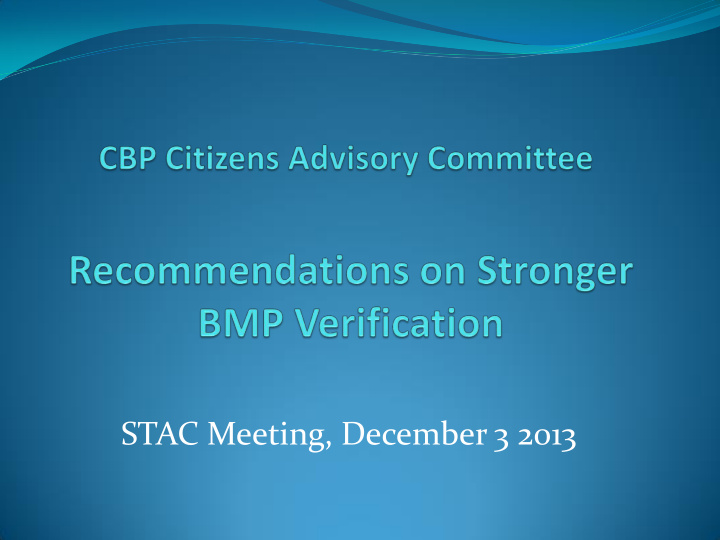



STAC Meeting, December 3 2013
Public credibility and effectiveness of Bay cleanup demand stronger verification that practices are being implemented and are working Status quo verification practices are not defensible CAC Letter: “Current verification process looks to fundamentally change, for the better, the way in which the CBP verifies the implementation of practices designed to reduce nutrient and sediment pollution.” How nutrient and sediment practices are being implemented and how well they are working CAC will be looking closely at how the jurisdictions respond in their protocols
Jurisdictions should focus first on improving verification of priority practices Need robust protocols for all types of BMPs in the Watershed Implementation Plans immediate focus needs to be on those BMPs which are most important Analysis shows the relative influence of different practices on nitrogen, phosphorus and sediment load reductions Need to target verification in geographic areas where the impact of these practices will show the greatest benefit
Problems of accounting for expired practices and double counting must be solved CAC Letter: “the new protocols must solve the problem of accounting for expired practices, and for double counting” Recommendations for defining project lifetimes by the BMP Verification Panel are very welcome
“Best professional” technical workgroup guidance to the jurisdictions for BMP verification is essential to form the benchmark for improvement Acknowledge funding constraints Focus improvements first on those BMPs on which they are counting the most for WIP implementation Narratives need to be clear about what types of data are necessary to make a confident judgment that a practice is functioning Promote consistency from state to state
“Best professional” technical workgroup guidance to the jurisdictions for BMP verification is essential to form the benchmark for improvement, continued… Statistical sampling evaluate how well state verification practices are working for testing whether assigned BMP efficiencies are really being achieved by the technologies Panel urges jurisdictions to “Aim High or Explain Why” Emulate the Urban Stormwater Workgroup Agriculture Workgroup-What does 80% confidence mean without narrative justification?
Jurisdictions’ protocols need to be spelled out in “plain English” Again, emphasis on transparency and public confidence Ag Workgroup needs explanation of verification measures and needed improvements CAC Letter: “The Program needs to ensure that any protocol and any assessment of the protocol can be clearly understood by the public.” Jurisdictions should explain their protocols not just with checklists or matrices
CAC’s greatest concern is about improving accountability and public confidence in the implementation of agricultural BMPs States are counting on enormous levels of agriculture BMP implementation to achieve the nutrient and sediment reductions in their WIPs Agriculture practices are generally most cost-effective Quality of verification for agricultural practices will affect how state and Bay Program verification is viewed overall CAC supported the creation of a workgroup on improving verification protocols for nutrient management plans status unknown
Accountability for Ag BMPs, continued… Where are the Agriculture Workgroup priorities? Value for an independent body of experts to be involved in preparation and/or review of the Agriculture verification guidance Concern of aggregate reporting of information about agricultural BMP implementation Let more light into the work of the government agencies who provide: farmer assistance, review and approve practices, inspect and gather farm information, and report BMP implementation
Accountability for Ag BMPs, continued… CAC Letter: “Protocols should require review of any aggregate information by a third party as well as a comparison between the aggregated information and real world marketing data (to analyze water quality implications.)” External independent review where aggregated data obscure transparency
Accountability for Ag BMPs, continued… Concern about the lack of accounting for manure exported from a CAFO to other areas clear and transparent accounting of the “fate of manure” is needed CAC is uncomfortable about the initiative to approve “functionally equivalent” BMPs in the Agricultural Workgroup The BMP Panel report makes some recommendations about how these proposals should be handled
How do we avoid a paperwork jungle and keep the focus on what’s being observed and how BMPs are functioning? CAC agrees with STAC comment: “The BMP verification process should not focus on documenting the BMP verification paper trail, but rather on verifying actual observations that BMPs exist and are functioning.”
Recommend
More recommend